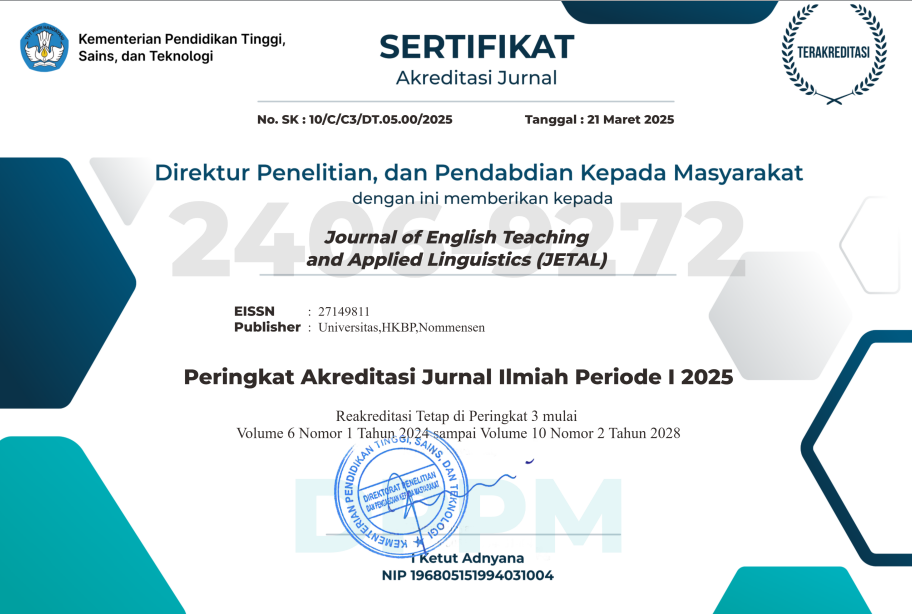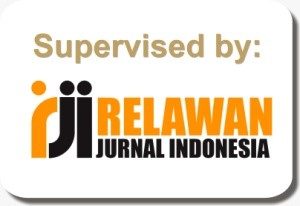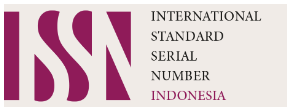Humor as an Approach Used by Teacher to Evoke Students’ Motivation in EFL Online Learning
Abstract
Covid-19 pandemic condition demands the learning activities to be conducted online. The current study aims to investigate the types of humor inserted by the teacher in the EFL online teaching-learning activities, and students’ responses toward the teacher’s humor. The participants of this descriptive qualitative research are an EFL teacher and 29 students of the 2nd grade at SMA Muhammadiyah Barru. To collect data about the types of humor used by the teacher, the researchers directly observe the online learning activities conducted by the teacher and his students. For gaining the deepest data about students’ responses toward the teacher’s humor, the researchers randomly interview 10 from those 29 students. The researchers found that in the online teaching-learning activities, the teacher inserted humorous words that based on the theory were classified into pun fan, joke, innuendo, malapropism, and absurdity. Besides that, the researchers also found new types of humor used by the teacher, which were then named as local humor and plesetan humor. From the interview result, it is found students’ responses towards the teacher’s humor indicate that humor maintains students’ focus in learning activities, stimulates students to solve problems quickly, and keeps students’ self-confidence in online learning.
References
Adams, C., & Pierce, R. L. (2006). Characteristics of Effective Teaching. from http:// www.lingofest.com/.../Characteristics%20of%20effective%20teaching.pdf
Attardo, & Raskin, V. (1991). Script Theory Revisited: Joke Similarity and Joke Representation Model. HUMOR: International Journal of Humor Research, 30/4(293-347).
Basu, S. (1999). Dialogic Ethics and the Virtue of Humor. Journal of Political Philosophy, 7(4), 378–403. doi: 10.1111/1467-9760.00082
Bell, N. D. (2009). Learning about and through Humor in the Second Language Classroom. Language Teaching Research, 13(3), 241-258.
Billig, M. (2005). Laughter and Ridicule: Towards a Social Critique of Humour. London: Sage.
Bogdan, R. C., & Biklen, S. K. (2007). Qualitative Research for Education: An Introduction to Theories and Methods. Boston: Pearson Allyn & Bacon.
Cann, A., & Cann, A. T. (2013). Humor Styles, Risk Perceptions, and Risky Behavioral Choices in College Students. HUMOR: International Journal of Humor Research, 26(4), 595-608.
Chandra, A. (2021). The Use of Virtual-Motivation to Engage Students on Lessons in Online Teaching. JELITA, 1-10.
Churiyah, M., Sholikhan, S., Filianti, F., & Sakdiyyah, D. A. (2020). Indonesia education readiness conducting distance learning in Covid-19 pandemic situation. International Journal of Multicultural and Multireligious Understanding, 7(6), 491-507. doi: http://dx.doi.org/10.18415/ijmmu.v7i6.1833
Dörnyei, Z., & Ushioda, E. (2011). Teaching and Researching Motivation (2nd ed.). Harlow: Longman.
Fishbah, A., & Toure, M. (2014). How to Measures Motivation. Journal of Personality ann Social Psychology, 328-341.
Fokkens-Bruinsma, M., & Canrinus, E. T. (2014). Motivation for becoming a teacher and engagement with the profession: Evidence from different contexts. International Journal of Educational Research, 65, 65-74.
Gaither, J. F. (2008). Questioning techniques: Research-based strategies teachers. from http://thesecondprinciple.com/teaching-essential/five-basic-types-questions
Gottfried, A. E. (1990). Academic Intrinsic Motivation in Young Elementary School Children. Journal of Educational Psychology, 82(3), 525–538.
Hyland, K., & Paltridge, B. (2011). Continuum Companion to Discourse Analysis. New York: Continuum International Publishing Group.
Kardena, A. (2020). Teachers’ Feedback in Group Works of EFL Learning: Does It Influence Students’ Success? JETAL: Journal of English Teaching & Applied Linguistics, 2(2), 29-36. doi: https://doi.org/10.36655/jetal.v2i2.277
Keller, J. M. (2010). Motivational Design for Learning and Performance. New York: Springer.
Kruse, B. G., & Prazak, M. (2006). Humor and Older Adults: What Makes Them Laugh? Journal of Holistic Nursing, 24(3), 188–193.
Lefcourt, H. M., & Martin, R. A. (1986). Humor and Life Stress: Antidote to Adversity. New York: Springer-Verlag.
Marples, R. (1999). The Aims of Education. London: Routledge.
Miles, M. B., & Huberman, A. M. (1994). Qualitative Data Analysis: An Expanded Sourcebook (2nd ed.). Thousand Oaks CA: Sage Publication.
Murphy, D. F. (1993). Evaluating Language Learning Tasks in the Classroom. In G. Crookes & S. Gass (Eds.), Tasks in a Pedagogical Context (pp. 139-161). Clevedon: Multilingual Matters.
Norrick. (2003). Issues in Conversational Joking. Journal of Pragmatics, 1333-1359, 1333-1359.
Rahardjo, A., & Pertiwi, S. (2020). Learning Motivation and Students’ Achievement in Learning English. JELITA, 1(2), 56-64.
Raskin, V. (1985). Semantic Mechanisms of Humor. Dordrecht: Reidel.
Sakai, H., & Kikuchi, K. (2009). An Analysis of Demotivators in the EFL Classroom. System, 37(1), 57–69.
Shammi, P., & Stuss, D. T. (2003). The Effects of Normal Aging on Humor Appreciation. Journal of the International Neuropsychological Society, 9(6), 855–863.
Tosun, S. (2015). The effects of blended learning on EFL students’ vocabulary enhancement. Procedia-Social and Behavioral Sciences, 199(1), 641-647. doi: 10.1016/j.sbspro.2015.07.592
Woo, E. M. W., Serenko, A., & Chu, S. K. W. (2019). An Exploratory Study of the Relationship between the Use of the Learning Commons and Students' Perceived Learning Outcomes. The Journal of Academic Librarianship, 45(4).
Authors retain copyright and grant the journal right of first publication with the work simultaneously licensed under a Creative Commons Attribution-ShareAlike 4.0 International License (CC BY-SA 4.0) that allows others to share the work with an acknowledgment of the work's authorship and initial publication in this journal.
Authors are able to enter into separate, additional contractual arrangements for the non-exclusive distribution of the journal's published version of the work (e.g., post it to an institutional repository or publish it in a book), with an acknowledgment of its initial publication in this journal.
Authors are permitted and encouraged to post their work online (e.g., in institutional repositories or on their website) prior to and during the submission process, as it can lead to productive exchanges, as well as earlier and greater citation of published work (See The Effect of Open Access).






